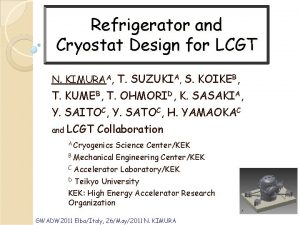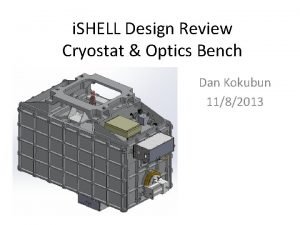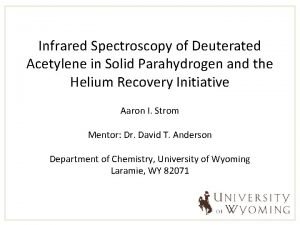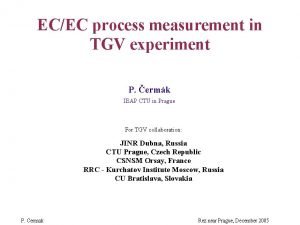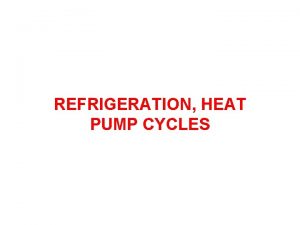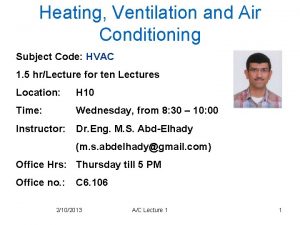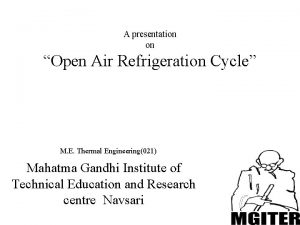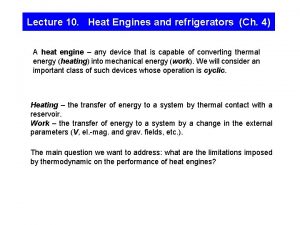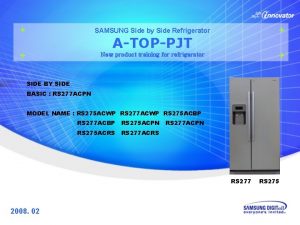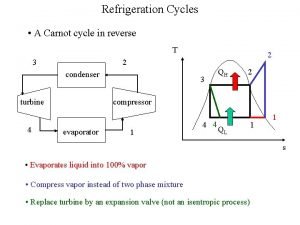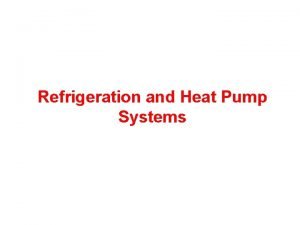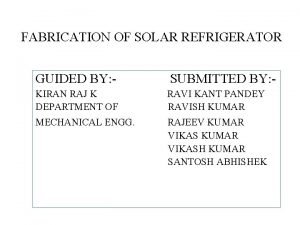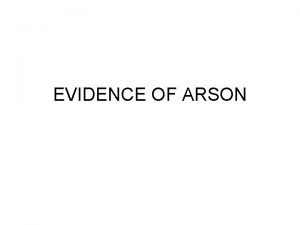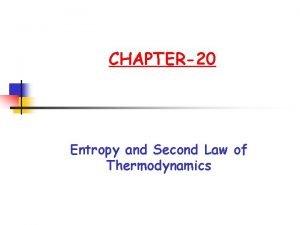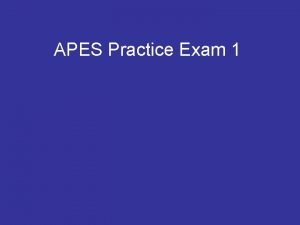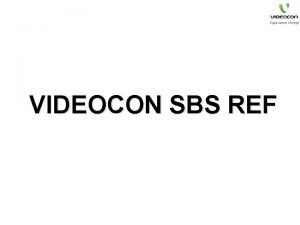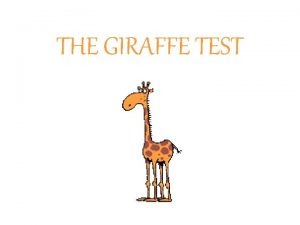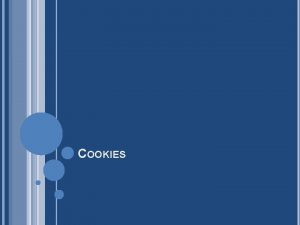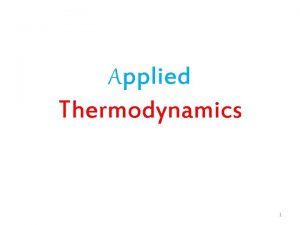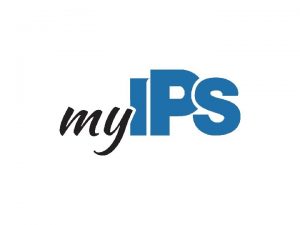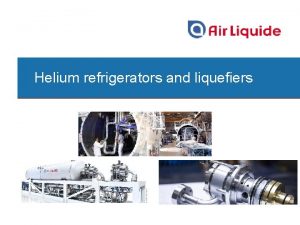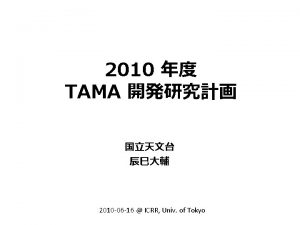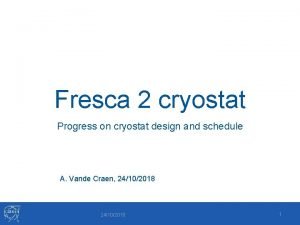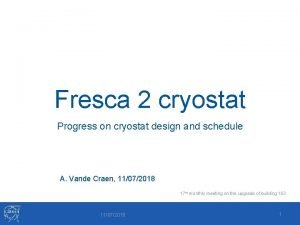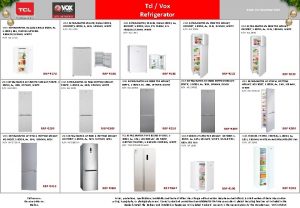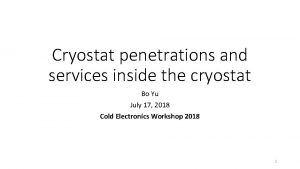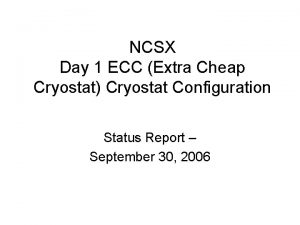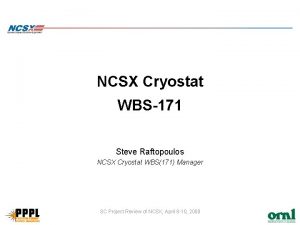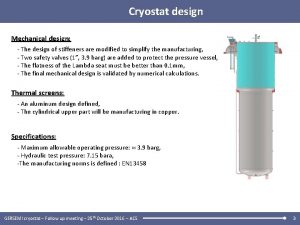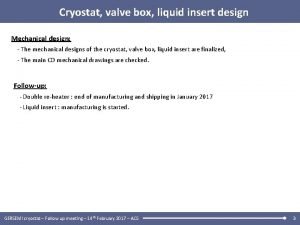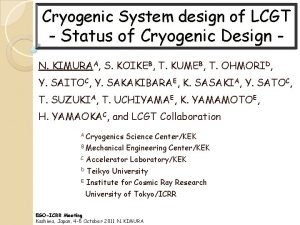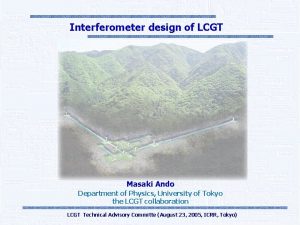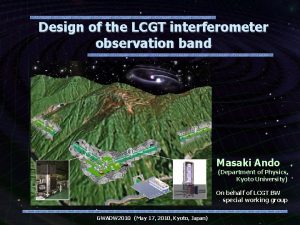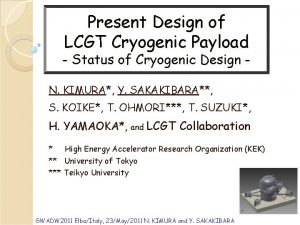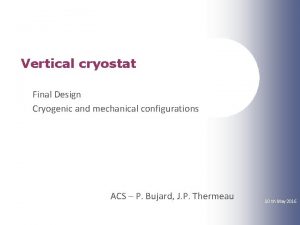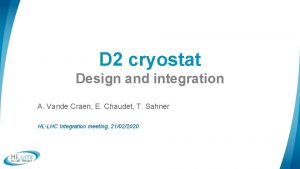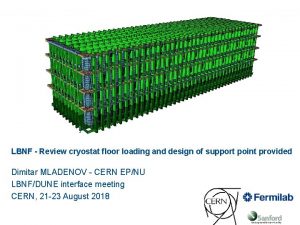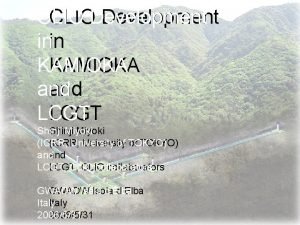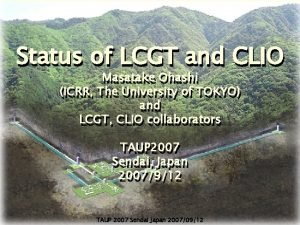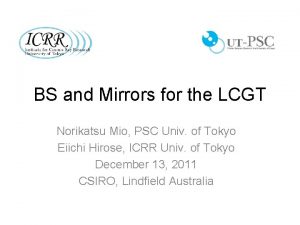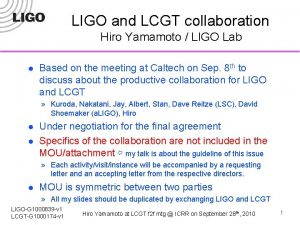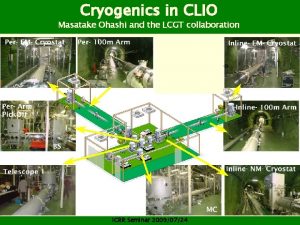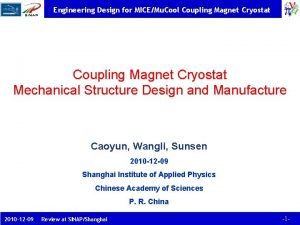Refrigerator and Cryostat Design for LCGT N KIMURAA


























- Slides: 26

Refrigerator and Cryostat Design for LCGT N. KIMURAA, T. SUZUKIA, S. KOIKEB, T. KUMEB, T. OHMORID, K. SASAKIA, Y. SAITOC, Y. SATOC, H. YAMAOKAC and LCGT Collaboration A Cryogenics Science Center/KEK B Mechanical Engineering Center/KEK C Accelerator Laboratory/KEK D Teikyo University KEK: High Energy Accelerator Research Organization GWADW 2011 Elba/Italy, 26/May/2011 N. KIMURA

Outline • LCGT cryogenics ü Cooling option for the Mirror ü Thermal Analysis ü Mechanical Analysis ü Materials (New MLI for LCGT) • Summary GWADW 2011 Elba/Italy, 26/May/2011 N. KIMURA 2

~3. 8 m Structure of Mirror Cryostat to SAS Cryostat Stainless steel t 20 mm Diameter 2. 4 m Height ~3. 8 m M ~V 10 ton iew AS L n Mai Drawn by S. Koike (KEK) Remote valve por ts Low vibration cryocooler unit am e b ER Main beam (1200 mm FL) m 2. 4 Cryocoolers Pulse tube, 60 Hz 0. 9 W at 4 K (2 nd) 36 W at 50 K (1 st) Cryostat with four cryocooler units GWADW 2011 Elba/Italy, 26/May/2011 N. KIMURA

Basic requirements from the LCGT cryogenics ISSUES • Temperature of the test mass/mirror : 20 [K] Inner radiation shield have to be cooled to < 8 K • Cool the mirror without introducing excess noise, especially vibration due to cryo-coolers. • Easy access and enough space for installation work around the mirror. • Satisfy ultra high vacuum specification < 10 -7 Pa Estimated by Dr. Uchiyama (ICRR) I was requested make a design for the LCGT cryostat from ICRR just One year ago! GWADW 2011 Elba/Italy, 26/May/2011 N. KIMURA

Cooling Option Our decision: Use CLIO type Cryo-cooler with low vibration mount for LCGT Heat Link Vibration Reduction Stage Cold Stage GWADW 2011 Elba/Italy, 26/May/2011 N. KIMURA VRS

Advantage and Disadvantage of CLIO type cryocooler unit Advantage Disappeared Items of design hasequipped been established since Basic Readyconcept to use Cryo-Cooler special cold stage, such as CLIO type the R&D done in CLIO. (2001~2003) Aluminum FRP tube as anti-vibration support rods High pure aluminum thin wire less than 0. 12 mm Disadvantage for heat link. components are unavailable today. Some critical Reasons arefor in the Substitutes the followings. Items Withdrawal business by social ◦Attach new design of cold stagecondition flanges ◦to. A mass-produced change of generation experienced workers 1 W/4 Kof PTC Replacetoor. Carbon renewal of tube the equipment of a factory ◦Replace FRP as anti-vibration support rods (stiffness AFRP > CFRP > GFRP) Start work with new company We have R&D to find substitutes! for development of high pure aluminum thin wire less than 0. 12 mm. GWADW 2011 Elba/Italy, 26/May/2011 N. KIMURA

Other Candidate => re-condensation cryo-cooler Example; SCGR meter, g-2 project at J-PARC The g-2 SC magnet is required with very high magnetic field uniformity below the level of 0. 1 ppm. Ø Field quality is sensitive to relative position btw yoke and coil Ø random & individual vibration due to mechanical resonance -> disturb uniform field It needed more R&D worker than to find substitutes materials for the new CLIO type cryo-cooler, when the project was started. GWADW 2011 Elba/Italy, 26/May/2011 N. KIMURA

An Estimated Break Down List of Thermal Budget 1 st Cold stage • Outer Shield (W) ◦ Eleven View Ports 22 ◦ Radiation From 300 K 70 ◦ Support post and Rods 24 ◦ Electrical wires 3 x 10 -4 Total W/unit 116 29 2 nd Cold stage • Inner Shield (W) ◦ Duct Shields* < 0. 05 (Beam and SAS) ◦ Eleven View Ports 0. 4 ◦ Radiation From 80 K 2. 2 ◦ Support post and Rods 2. 4 ◦ Electrical wires 3 x 10 -4 ◦ Mirror Deposition 0. 9 ◦ Scattering Light ? Total W/unit 5. 9 1. 5 *Heat Load of Duct Shields was presented by Mr. Sakakibara on Monday. GWADW 2011 Elba/Italy, 26/May/2011 N. KIMURA 8

Estimated Thermal Budget Estimated Heat Loads at the radiation shields and Support posts and rods 70 W by the radiation at 80 K outer shield 2. 2 W by the radiation at 8 K inner shield 2. 4 W by the radiation and conduction (support posts and tension rods) at 8 K 24 W by the radiation and conduction (support posts and tension rods) at 80 K Very High Purity Aluminum Conductor (5 N 8) Low Vibration Cryo-cooler unit GWADW 2011 Elba/Italy, 26/May/2011 N. KIMURA 9

Example of Thermal Conductivity of 6 N-class Very High Pure Aluminum* 40, 000 W/m/K @ 6 K 6 N Aluminum 5 N up Al RRR=3000 2 N Aluminum ~Type A-1070 For outer shield For inner shield Cost: 5 N 8 > 2 N Aluminum We must put the right material the right GWADW 2011 Elba/Italy, 26/May/2011 N. in KIMURA position.

Estimated Thermal Budget Estimated Heat Loads at the radiation shields and Support posts and rods 94 K at the top of the 80 K outer shield (A 1070) 7. 4 K at the top of the 8 K inner shield (5 N 8+A 1070) < 8 K at Connection point with IM 47 K at 1 st cold stage of Cryo-cooler d. T 1 st = 26 K 6. 5 K at 2 nd cold stage of Cryocooler d. T 2 nd=0. 5 K GWADW 2011 Elba/Italy, 26/May/2011 N. KIMURA 11

Rough Estimation of the PTC* operation with 20 ppm deposition by Scattering Light at 400 k. W Heat load/Unit= 400 k. W * 20 ppm / 4 units = 2 W/unit 5 W/50 W d. Q=2 11 KW 4 W/40 W 23 K 20 ppm deposition may be accepted, *PTC: Pulse Tube-type Cryocoo but we lost contingency cooling power of 2 W. GWADW 2011 Elba/Italy, 26/May/2011 N. KIMURA

Doors for access to inside S. Koike W 1020 mm X h 1600 mm Inner shield GWADW 2011 Elba/Italy, 26/May/2011 N. KIMURA W 1600 mm X h 1900 mm Outer shield

Static deformation analysis Main vacuum duct and the duct to SAS are not connected. Boundary conditions ◦ periphery of the bottom : fix GWADW 2011 Elba/Italy, 26/May/2011 N. KIMURA S. Koike

Modal analysis Boundary condition: fix the perimeter of the bottom * Interface to SAS is not fixed at the moment. S. Koike Resonance Frequency GWADW 2011 Elba/Italy, 26/May/2011 N. KIMURA

Structure of Radiation Shields Flame by A 6000 Aluminum Secure stiffness of the radiation shields Outer Shields GWADW 2011 Elba/Italy, 26/May/2011 N. KIMURA Inner Shields

Modal analysis of outer shield Mode frequency M= Remove support rod Mode Frequency M= GWADW 2011 Elba/Italy, 26/May/2011 N. KIMURA S. Koike

Modal analysis of inner shield Frequency M= GWADW 2011 Elba/Italy, 26/May/2011 N. KIMURA S. Koike

Response to ground motion Jan. 31 st, 2011 H. Yamaoka Input to peripheral of bottom Mozumi 50 m K. Y. 2005 GWADW 2011 Elba/Italy, 26/May/2011 N. KIMURA

Cryo-top Response to ground motion Cryo-F Cryo-L Cryo-R Y方向 X-direction X方向 Input Y-direction

MLI utilizes quite a lot of aluminized thin polyester films as radiation shields. The polyester film exhausts water vapor, which may dim the optical system of the Laser-Interferometer. The exhaust rate of the water vapor may be reduced much at cryogenic temperature. But it is important to know the general characteristics of out-gas rate at room temperature. GWADW 2011 Elba/Italy, 26/May/2011 N. KIMURA

To reduce the total amount of out-gas, Thickness thin of polyester film must be Light Weight MLI Total number of films in MLI must be reduced High Thermal Resistance GWADW 2011 Elba/Italy, 26/May/2011 N. KIMURA

Specifications of Candidate MLI : KFP-9 B 08 ( provided by Tochigi Kaneka Co. , Ltd. ) Type of MLI Double Aluminized Polyester Film Laminated with Separator Material All Polyester Thickness Specific weight Surface Resistance of Vapor Deposited Aluminum Layer : Rs less than for each side of DAM Thickness of Aluminum Layer *1 more than 50 nm for each side of DAM Normal Emissivity Less than 0. 1 for non-laminated side Less than 0. 6 for laminated side *1 : estimated by the aluminum thickness data obtained by the atomic absorption spectroscopy reported by Teikyo University in the International Conference of Cryogenic Engineering, 2010 GWADW 2011 Elba/Italy, 26/May/2011 N. KIMURA

The measurement is now underway MLI : Kaneka KFP-9 B 08 Back ground (SUS Chamber) GWADW 2011 Elba/Italy, 26/May/2011 N. KIMURA

(2) High Thermal Resistance Heat transfer mechanisms in MLI q t = qr + qc Radiation term qr and Conduction term qc are comparable at good fabrication condition. Conduction term is governed by contact pressure between reflective films at the self-compression state. Radiation term is governed by total number of films. Thin polyester film will reduce the contact pressure from thermal resistance point of view. ⇒ Light weight MLI GWADW 2011 Elba/Italy, 26/May/2011 N. KIMURA

Summary The design of the mirror cryostat for LCGT satisfying requirements was almost finished in one year. The production of the components for the cryostat will be started after contractor decided. Performance of the first cryostat will be demonstrated on the mid of 2012 Jfy. Proto type cryo-cooler units replaced with substituted materials will be completed on the end of this June. Performance of the first cryo-cooler will be confirmed on the mid of this July. GWADW 2011 Elba/Italy, 26/May/2011 N. KIMURA 26
 Kimuraa
Kimuraa Cryostat
Cryostat Cryostat
Cryostat Cryostat procedure
Cryostat procedure Cryostat processing
Cryostat processing Difference between refrigerator and heat pump
Difference between refrigerator and heat pump Hvac subject
Hvac subject Open air refrigeration cycle diagram
Open air refrigeration cycle diagram Your refrigerator and pantry are the major items here.
Your refrigerator and pantry are the major items here. Difference between heat engine and refrigerator
Difference between heat engine and refrigerator Pthtm 100md
Pthtm 100md Carnot cycle refrigerator
Carnot cycle refrigerator Coefficient of performance of refrigerator
Coefficient of performance of refrigerator Fabrication of thermoelectric refrigerator
Fabrication of thermoelectric refrigerator Arson evidence collection and analysis
Arson evidence collection and analysis Refrigerator entropy
Refrigerator entropy Full cost pricing of a refrigerator would include
Full cost pricing of a refrigerator would include Whats socioeconomic status
Whats socioeconomic status Videocon side by side refrigerator
Videocon side by side refrigerator Giraffe test
Giraffe test Blood bank refrigerator quality control
Blood bank refrigerator quality control Refrigerator cookies contain a high proportion of fat
Refrigerator cookies contain a high proportion of fat Refrigerator definition in thermodynamics
Refrigerator definition in thermodynamics Leslie has 1 liter of milk in her refrigerator
Leslie has 1 liter of milk in her refrigerator Is paint drying a chemical change
Is paint drying a chemical change Air liquide
Air liquide Do refrigerator cookies contain a high proportion of fat
Do refrigerator cookies contain a high proportion of fat
